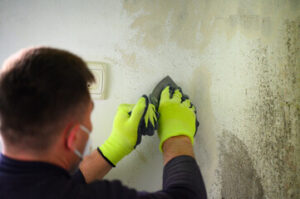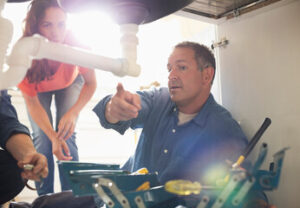Mold Removal Bronx NY professional will evaluate the extent of the problem and inspect for hidden mold. They will also test air quality and identify the type of mold present.
During the cleaning process, non-porous surfaces will be wiped down with biocide and scrubbed to kill spores. Mold-damaged porous materials will be bagged and carried away to prevent spores from settling elsewhere.

1. Cleaning
Mold is not just unsightly, but it can also pose health risks. Inhaling mold spores can trigger allergies, asthma, and even fungal infections. For these reasons, you should never ignore any visible mold spores. In fact, if you spot any mold growing in your home, it is important to start cleaning immediately.
First, you need to examine the extent of the mold. This involves determining how much surface area is affected and the type of mold. This will help you determine the appropriate method of removal and remediation.
In general, most molds can be removed using a combination of vinegar and detergent. To clean a contaminated surface, add a solution that’s equal parts white vinegar and water to a spray bottle. Apply the solution to the moldy surface and scrub it. If the area is large, use a brush with a long handle. Once the surface is clean, rinse it with clean water. Repeat as needed until the mold is gone.
For porous materials like drywall and wood, make sure to use an environmentally-safe soap or borax solution. Avoid bleach, which can stain. After scrubbing, it’s important to dry the area. Adding fans and dehumidifiers can speed up the process. You should also try to keep humidity below 50%, as mold thrives in damp areas.
When addressing an extensive mold problem, it’s best to call in a professional. This is especially true for hidden areas, such as behind walls and in insulation. A pro can use specialized air-cleaning equipment to remove the mold and fix the moisture problem that caused it to grow.
According to the EPA, it’s typically possible to remove small areas of mold yourself, as long as the mold doesn’t cover more than a few square feet. However, it’s important to wear proper personal protective equipment (PPE) when handling mold, including gloves, safety glasses, and a N95 or P-100 respirator. It’s also recommended to seal off the affected area from unaffected areas to prevent spores from spreading.
If you’re unsure how serious your mold infestation is, a testing kit can provide a valuable diagnostic tool. These kits include a swab, a petri dish, instructions, and a mailer to send the sample away for analysis.
2. Sterilization
Mold isn’t just unsightly, but it can also destroy materials, eat away at wood and break down insulation. In addition, some types of mold are toxic and can cause a host of health problems. The key to keeping mold at bay is moisture control. This means scrubbing moldy surfaces with detergent and water, and repairing any leaks as soon as possible to prevent further problems. It’s also important to dehumidify the affected area, and clean regularly with non-toxic cleaning products.
Mold removal specialists use a variety of sterilization methods, including steam, ethylene oxide (EO) gas, and dry heat. These methods achieve an effective reduction of bacterial counts in the presence of a biological indicator. In most cases, this is measured by a minimum inhibitory concentration test.
A typical test uses a solution of known numbers of “biological indicators” that are highly resistant to the sterilization process, such as the spores from an oat strain or a bacteria culture. This is then exposed to the sterilizing agent, and the number of viable organisms is counted. The results are compared with the bioburden of the item being sterilized.
The goal of sterilization is to achieve a minimum inhibitory concentration value of 106 CFU/mL for all microorganisms, and the spores in particular. However, there are many factors that can influence how well a sterilization method works. This is why it’s important to choose a certified professional who can assess and determine the best approach for your situation.
Before a technician begins the mold remediation process, they will set up containment to keep airborne spores from spreading to other areas. They will also wear personal protective equipment such as boots, gloves and a mask at a minimum.
In addition, they will use a vacuum with a HEPA filter to remove airborne particles from the affected area. If the area is large, they may also use a portable dehumidifier to pull moisture out of the air. They will then sanitize and deodorize the affected areas using an antimicrobial or fungicide product. Then, they will use a HEPA air scrubber to clear the remaining spores.
3. Disposal
Mold and mildew are not just unsightly, they can be hazardous to your health. Inhaling mold spores can trigger respiratory problems, eye irritation and other symptoms in people who are sensitive to it. These symptoms can range from a simple cough and wheeze to fever, headaches and difficulty breathing. Those who work in construction or who are exposed to large amounts of black mold on a regular basis may experience more severe reactions.
Mold thrives in wet areas and needs two things to grow: water and a food source. Mold spores float through the air and latch onto surfaces, where they grow into colonies. Mold can grow on paper, wallpaper glue, fabric, wood, soap scum, sheetrock and many other materials. It grows faster in warm temperatures and high humidity levels.
The first step in removing mold is to determine the cause of the problem, which may involve repairing leaks or reducing humidity levels. Then, cleaning the affected area to remove any visible mold and mildew growth is done. The next step involves encapsulating the area to prevent future mold growth.
Proper mold removal requires the use of personal protective equipment, such as a face mask and rubber gloves. A misting of the affected area helps control the number of mold spores released into the air during the cleaning process. Nonporous surfaces are usually cleaned and sanitized with detergent solutions. Porous materials are often removed and discarded in plastic bags, which are then double-bagged and sealed to prevent mold spores from becoming airborne during disposal.
If you have a lot of waste from a mold removal project, hiring someone to take care of it for you may save you time and money. Companies such as 1-800-GOT-JUNK? specialize in cleaning and disposing of debris from home improvement projects, including mold cleanup. They will take care of the heavy lifting, leaving you with a clean space to get back to your daily routine.
If you suspect you have a mold infestation, a mold testing kit can help determine the type of mold in your home and how extensive the problem is. The kits typically include a swab, a petri dish, gloves and a mailer to send the sample to a lab for analysis. The results of the test will be e-mailed to you within a few days.
4. Remediation
The final step, remediation, is a comprehensive process that ensures that the mold issue is resolved and won’t return. Experts assess the moisture problem, fix it (such as a leak or improper ventilation), remove all affected materials and clean or replace them, and clear the air of spores to prevent new growth.
To begin, professionals isolate the infected area with plastic sheets and physical barriers to prevent spores from spreading. They will also use negative air pressure to keep spores from blowing around. During this step, the pros will also remove porous or absorbent materials such as carpeting and drywall. These will be disposed of properly according to environmental regulations and the experts’ guidelines. Nonporous surfaces like counters, sinks and metals will be cleaned with disinfectant sprays. The experts may also use commercial-grade antimicrobial sprays to kill spores on porous items that cannot be removed, such as wooden wall studs.
After cleaning the space, experts will apply an EPA-approved biocide to the entire affected area, killing any remaining spores and making them unable to grow back. This liquid is typically brushed or sprayed onto the surface and then left to set overnight before it can be deemed effective. The professionals will then vacuum, scrub and wipe the nonporous surfaces again to eliminate spores from the air. Finally, they will clear the air of spores with HEPA filters and other tools and equipment.
Once the air has been cleared, the professionals will perform a clearance test to ensure that the space is safe for home occupation or reoccupation. This involves testing for the presence of spores and visible mold, as well as checking for moisture levels in walls and floors. Ideally, the moisture level should be below 10% before homeowners move back in, and the professionals will verify this by visiting the home soon after the mold cleanup. In addition, the home should be inspected for any recurring water damage or moldy odors. If there is, the mold removal and remediation processes should be repeated until all signs of moisture problems have been corrected.


